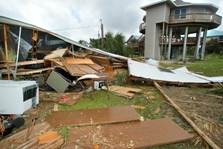Circles Unbroken
Round homes in Katrina's path sustained no structural damage from high winds or water, although many were hit with tidal surges of 20 to 30 feet.
- By Melissa Stanz
- Jul 01, 2010
Natural disasters come in many shapes and sizes. Most of them involve high winds and water. Images of people on rooftops in New Orleans after Hurricane Katrina's storm surge still linger in our minds, and video showing thousands of flattened homes all along the Gulf Coast testify to the power of wind and water.
Given the history of severe weather on the coast, sometimes it seems the smart choice is not to build there at all, but that's not realistic or desirable. Living in an extreme weather climate means giving some thought to how you build and building to minimize damage during extreme weather. Too complex? Think again.
 The hit reality show "Extreme Makeover: Home Edition" decided to make a difference in New Orleans, an area hit hard by Hurricane Katrina. The team selected a family home and a church to build, choosing a round home design for both buildings. They selected this design based on a long history of round homes surviving severe weather, realizing this design would accomplish the family's and the church's requests for a "storm proof" building. Nearly 20 builders, manufacturers, and hundreds of volunteers created these new homes as a labor of love, building them in just four days and leaving behind beautiful round structures that are LEED Platinum certified.
The hit reality show "Extreme Makeover: Home Edition" decided to make a difference in New Orleans, an area hit hard by Hurricane Katrina. The team selected a family home and a church to build, choosing a round home design for both buildings. They selected this design based on a long history of round homes surviving severe weather, realizing this design would accomplish the family's and the church's requests for a "storm proof" building. Nearly 20 builders, manufacturers, and hundreds of volunteers created these new homes as a labor of love, building them in just four days and leaving behind beautiful round structures that are LEED Platinum certified.
There are several other options available that will also minimize risk of building in a severe weather zone, including concrete and some log homes. But "Extreme Makeover: Home Edition" chose the circular style home based on the evidence. They knew the circular homes in Katrina's path sustained no structural damage from high winds, and although many were hit with tidal surges of 20 to 30 feet, they still had no structural damage.
Round Rules of the Road
Why do round homes work so well in severe weather? The answer is aerodynamics. Round homes have less exterior surface area than traditional rectangular homes, reducing the surfaces in contact with outside elements such as wind.
"A correctly shaped round home presents a lower drag coefficient than a rectangular home, sort of like the difference between a sports car and a van going down the highway. What this means is that the wind exerts less pressure and force on the structure--up to 30 percent less force than a rectangular shape. Basically, the shape works with the wind instead of against it," said Ben Poss, P.E., director of Engineering for Deltec Homes.
The round home building process includes floor and roof truss systems. Half scissor roof trusses are locked into place like the hub of a wheel, radiating out from the center like spokes. The floor system works in the same manner so when any side of the home comes under duress from high wind, that energy is spread throughout the entire structure, much as a wheel works. This continuous structural tie lends itself to a severe weather environment and roofs simply stay put.
Round homes take advantage of natural shapes; the circle is the strongest shape in nature, and the triangle is the strongest shape in geometry. Circular style homes combine the triangles to make circles, so they are uncommonly strong, absorbing the seismic energy of a hurricane or other severe weather. In short, they work with nature, not against it.
Some round homes also include wall panels with continuous structural sheathing that is constructed to resist small flying objects and debris. These panels are tested to meet the stringent requirements of the Florida Building Code, the toughest code in the nation. A continuous perimeter header in the walls--even where there are no doors or windows--also protects some round homes from falling, objects such as telephone poles or trees.
Based on their long history of surviving severe weather, it makes sense that if it were code to build only round homes or similar severe-weather-resistant structures in coastal areas, insurance rates and claims would probably plummet. This would save millions of dollars for homeowners and taxpayers and probably would save lives, too. That's something to think about the next time you see the effects of a hurricane.
This article originally appeared in the July 2010 issue of Occupational Health & Safety.